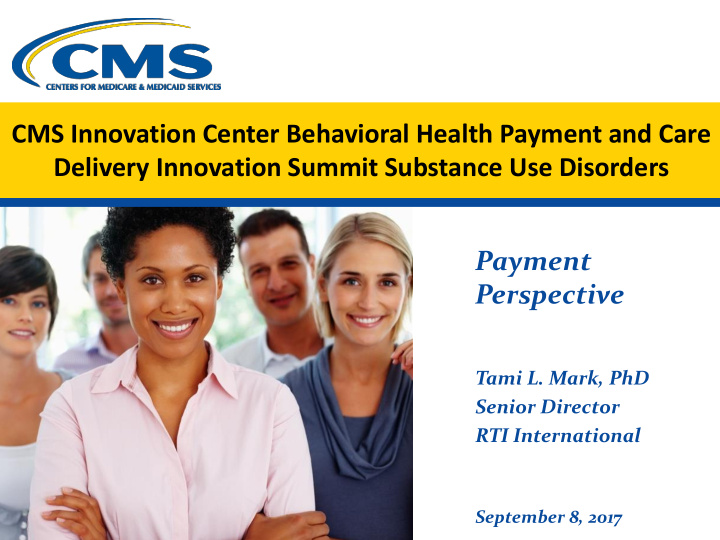



CMS Innovation Center Behavioral Health Payment and Care Delivery Innovation Summit Substance Use Disorders Payment Perspective Tami L. Mark, PhD Senior Director RTI International September 8, 2017
Outline • Coverage of SUD • How SUD Coverage Affects Outcomes • Coverage Challenges 2
Health Insurance of Individuals with SUD 59% 24% 18% 16% 7% Uninsured Uninsured Medicaid Private Medicare (2012) (2015) (2015) (2015) (2015) Source: Author Analysis National Survey of Drug Use and Health
SUD Coverage Limits SUD HOSPITAL DAYS SUD OFFICE VISITS 64% 65% 0% 0% in 2006 in 2006 in 2015 in 2015 4 Sources: Gabel, 2007; ASPE, 2012; Horgan et al., 2016; Thalmayer, 2017
Medicaid Coverage of SUD Services 76% 67% 61% 51% 47% 33% 27% 18% SBIRT Medically Residential Intensive Psychotherapy Other therapies Peer Support Supported monitored services outpatient employment detox 5 Source: MACPAC, 2017
Medicaid Coverage of Addiction Medications Number of Medicaid Programs Disulfiram 51 Alcohol Dependence Medications Acamprosate 36 15 Extended-Release Naltrexone 31 2 18 Alcohol and Opioid Dependence Oral Naltrexone 51 Medications Methadone 31 20 Opioid Dependence Buprenophine/Buprenorphine-naloxone Medications 51 All of the Above Medications 19 21 11 Included on PDL ot Included on PDL Unknown 6 Source: Substance Abuse and Mental Health Services Administration, 2014.
SUD Coverage Effects on Outcomes Financial protection Improved access to treatment Improved outcomes Reduced costs ? System level health outcomes 7
Challenges: Moving SUD Payment from Volume to Value Measurement based care Coordination across acute and non-acute and Population reporting SUD specialty and non- capabilities SUD specialty settings Quality assurance and Use managed care reporting infrastructure techniques effectively Treatment in “ medical Non-traditional and settings ” and by prescribing social services professionals 8
Encourage Measurement Based Care 9 Source: Cacciola et al, 2013
Develop Population Reporting 10 Source: Vermont Department of Health
Quality Assurance and Reporting Infrastructure 11 Source: Nursing Home Compare
Build on Existing State/Federal Infrastructure 12 Source: Connecticut Department of Mental Health and Addiction Services, http
Expand Addiction Treatment in ”Medical Settings” and by Prescribing Professionals SUD and Buprenorphine Physician Office Visits Number of Physician Office Visits 20,000,000 SUD Office Visits Buprenorphine Rx 18,000,000 16,000,000 14,000,000 12,000,000 10,000,000 8,000,000 6,000,000 4,000,000 2,000,000 0 1995 1996 1997 1998 1999 2000 2001 2003 2004 2005 2006 2007 2008 2009 2010 2011 2012 2013 2014 13 Source: Author analysis of the National Ambulatory Care Survey
Appropriate Use of Utilization Review Prior Authorization Required 48 13 12 12 5 5 14 Source: SAMHSA, 2014
Coordination Across Acute and Non-Acute and SUD Specialty and Non-SUD Specialty Settings Access to Services not Traditionally Covered Under Insurance Integrated Health System for Addictions Treatment Family Corrections Services Probation and Parole Spokes Nurse-Counselor team Mental Residential With prescribing MD Health Services Services HUB Assessment Care Coordination Spokes Spokes Methadone Complex Addictions Consultation Substance In Patient Spokes Abuse Services Nurse-Counselor team Out-PT Treatment With prescribing MD Pain Medical Management Homes Clinics 15 Source: Knopf. Vermont Hub and Spoke System, 2016
References 1. Gabel JR, Whitmore H, Pickreign JD, Levit KR, Coffey RM, Vandivort-Warren R. Substance abuse benefits: still limited after all these years. Health Aff (Millwood). 2007 Jul-Aug;26(4):w474-82. Epub 2007 Jun 7. PubMed PMID: 17556380 2. Horgan CM, Hodgkin D, Stewart MT, Quinn A, Merrick EL, Reif S, Garnick DW, Creedon TB. Health Plans' Early Response to Federal Parity Legislation for Mental Health and Addiction Services. Psychiatr Serv. 2016 Feb;67(2):162-8. 3. Thalmayer AG, Friedman SA, Azocar F, Harwood JM, Ettner SL. The Mental Health Parity and Addiction Equity Act (MHPAEA) Evaluation Study: Impact on Quantitative Treatment Limits. Psychiatr Serv. 2017 May 1;68(5):435-442 4. Assistant Secretary for Planning & Evaluation. Consistency of Large Employer and Group Health Plan Benefits with Requirements of the Paul Wellstone and Pete Domenici Mental Health Parity and Addiction Equity Act of 2008. https://aspe.hhs.gov/execsum/consistency-large-employer- and-group-health-plan-benefits-requirements-paul-wellstone-and-pete-domenici-mental-health- parity-and-addiction-equity-act-2008 5. Friedman S, Xu H, Harwood JM, Azocar F, Hurley B, Ettner SL. The Mental Health Parity and Addiction Equity Act evaluation study: Impact on specialty behavioral healthcare utilization and spending among enrollees with substance use disorders. J Subst Abuse Treat. 2017 Sep;80:67-78. 6. MACPAC, Medicaid and the Opioid Epidemic. Chapter 2. June 2017 Report to Congress. 16
References Continue 7. Substance Abuse and Mental Health Services Administration. (2014). Medicaid Coverage and Financing of Medications to Treat Alcohol and Opioid Use Disorders. HHS Publication No. SMA- 14-4854. Rockville, MD: Substance Abuse and Mental Health Services Administration. 8. Kaiser Family Foundation. Key Facts About the Uninsured Population. September 2016. http://www.kff.org/uninsured/fact-sheet/key-facts-about-the-uninsured-population/ 9. Mattick RP, Breen C, Kimber J, Davoli M. Buprenorphine maintenance versus placebo or methadone maintenance for opioid dependence. Cochrane Database Syst Rev. 2014 Feb 6;(2):CD002207. 10. Mattick RP, Breen C, Kimber J, Davoli M. Methadone maintenance therapy versus no opioid replacement therapy for opioid dependence. Cochrane Database Syst Rev. 2009 Jul 8;(3):CD002209. 11. Mohlman MK, Tanzman B, Finison K, Pinette M, Jones C. Impact of Medication-Assisted Treatment for Opioid Addiction on Medicaid Expenditures and Health Services Utilization Rates in Vermont. J Subst Abuse Treat. 2016 Aug;67:9-14. doi: 10.1016/j.jsat.2016.05.002. 17
References Continue 12. Wickizer TM, Mancuso D, Huber A. Evaluation of an innovative Medicaid health policy initiative to expand substance abuse treatment in Washington State. Med Care Res Rev. 2012 Oct;69(5):540- 59. doi: 10.1177/1077558712447075. Epub 2012 May 22. PubMed PMID: 22618867. 13. Nielsen S, Larance B, Degenhardt L, Gowing L, Kehler C, Lintzeris N. Opioid agonist treatment for pharmaceutical opioid dependent people. Cochrane Database Syst Rev. 2016 May 9;(5):CD011117 14. James R. McKay, Ph.D., Brief Addiction Monitor. https://www.mentalhealth.va.gov/communityproviders/docs/BAM_Overview_01-28-2014.pdf 15. Cacciola JS, Alterman AI, Dephilippis D, Drapkin ML, Valadez C Jr, Fala NC, Oslin D, McKay JR. Development and initial evaluation of the Brief Addiction Monitor (BAM). J Subst Abuse Treat. 2013 Mar;44(3):256-63. doi: 10.1016/j.jsat.2012.07.013. 16. Knopf, A. Vermont’s Hub -and-Spoke System Could be a Model for OPTs. ATForum, October 11, 2015 http://atforum.com/2016/10/vermonts-hub-spoke-system-model-otps 18
Recommend
More recommend